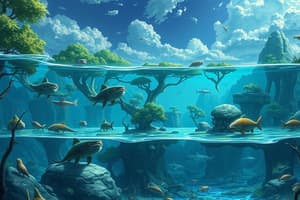Podcast
Questions and Answers
What is a trophic level?
What is a trophic level?
The trophic level of an organism is the position it occupies in a food chain.
What is an autotroph?
What is an autotroph?
An autotroph is an organism that produces complex organic compounds from simple substances, generally using energy from light or inorganic chemical reactions.
What is a heterotroph?
What is a heterotroph?
A heterotroph is an organism that cannot produce its own food and instead relies on consuming organic carbon.
What are detritivores?
What are detritivores?
What is a primary consumer?
What is a primary consumer?
What is a secondary consumer?
What is a secondary consumer?
What is a tertiary consumer?
What is a tertiary consumer?
What is a quaternary consumer?
What is a quaternary consumer?
What is a food web?
What is a food web?
An energy pyramid represents the distribution of energy among different _______.
An energy pyramid represents the distribution of energy among different _______.
Flashcards are hidden until you start studying
Study Notes
Trophic Levels
- Refers to the position an organism occupies in a food chain
- Derived from Greek "τροφή" (trophē) meaning food or feeding
- Represents a succession of organisms that consume each other
Autotroph
- Also known as producers
- Organisms that create complex organic compounds from simple substances
- Typically utilize light energy or inorganic chemical reactions
Heterotroph
- Organisms that are unable to produce their own carbon
- Depend on organic carbon sources for growth
Detritivore
- Also named detritophages or saprophages
- Heterotrophs that obtain nutrients by consuming detritus (decomposing organic matter)
- Include various invertebrates, vertebrates, and plants that may engage in coprophagy (consuming feces)
Primary Consumer
- Organisms that feed on autotrophs, also known as herbivores (e.g., rabbits eating grass)
- Form the next link in the food chain which leads to secondary consumers (e.g., snakes that eat rabbits)
Secondary Consumer
- Eat primary consumers and are categorized as carnivores (meat-eaters) or omnivores (both plant and animal eaters)
- Important in the transfer of energy within ecosystems
Tertiary Consumer
- Apex carnivores in food chains that consume secondary consumers
- Play a crucial role in controlling populations of other carnivores
Quaternary Consumer
- Feed on tertiary consumers and are also carnivores
- Example includes top predators like hawks, which dominate their food chain
Food Web
- A complex network representing the interconnections among various food chains in an ecological community
- Depicts multiple feeding relationships and energy flow within ecosystems
- Also referred to as a consumer-resource system
Energy Pyramid
- Representation of energy distribution at various trophic levels within an ecosystem
- Illustrates the decrease in available energy as one moves up the trophic levels
Studying That Suits You
Use AI to generate personalized quizzes and flashcards to suit your learning preferences.




